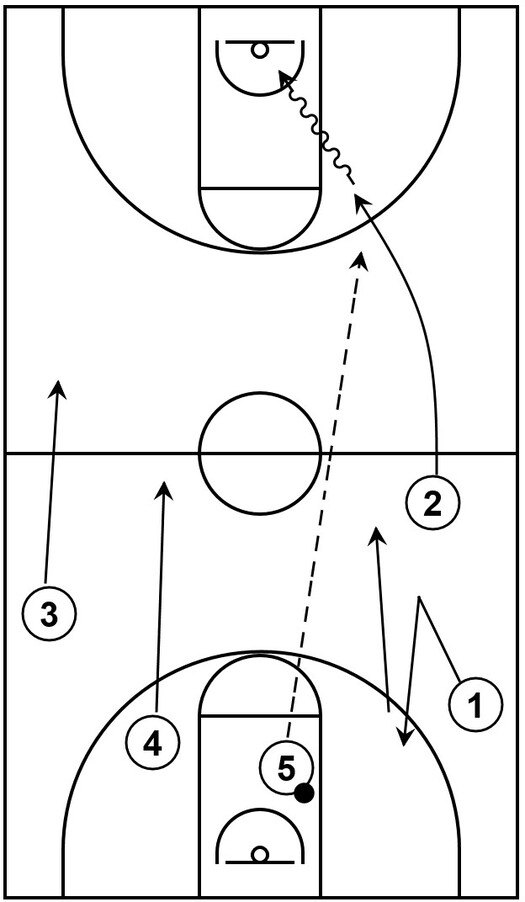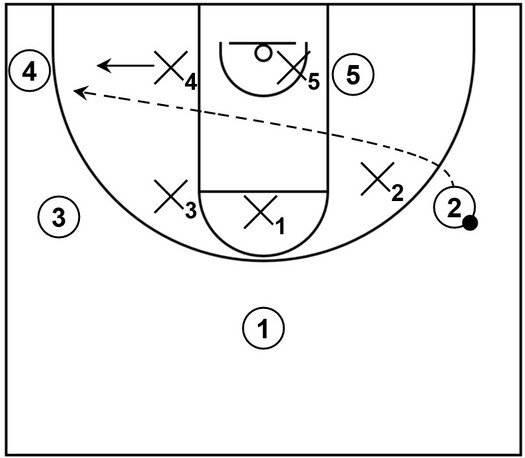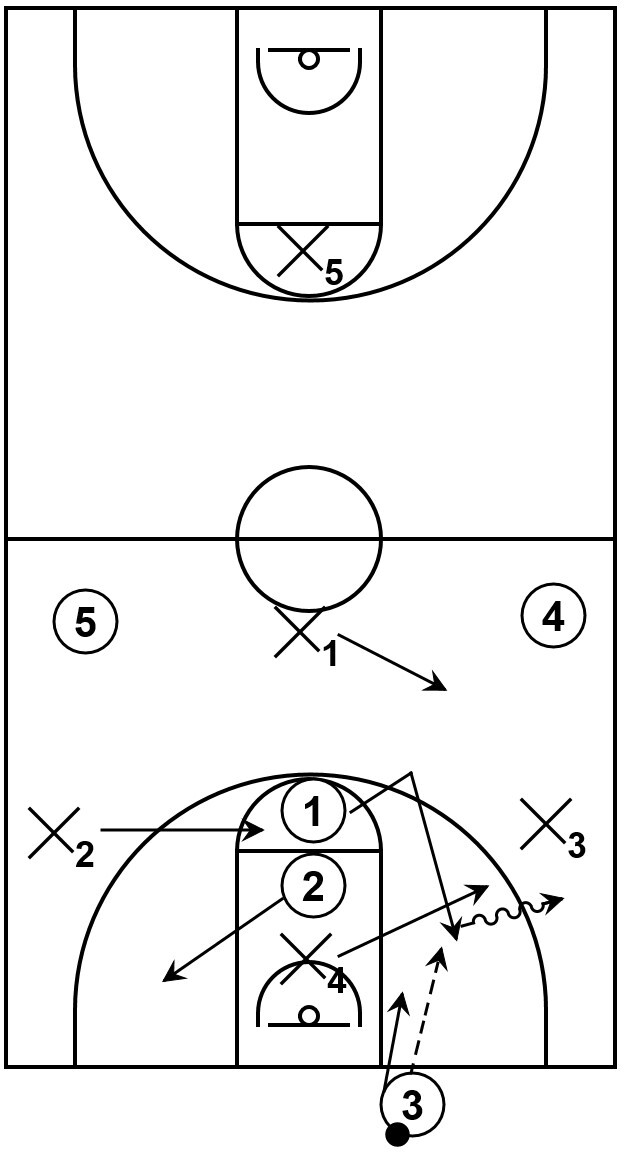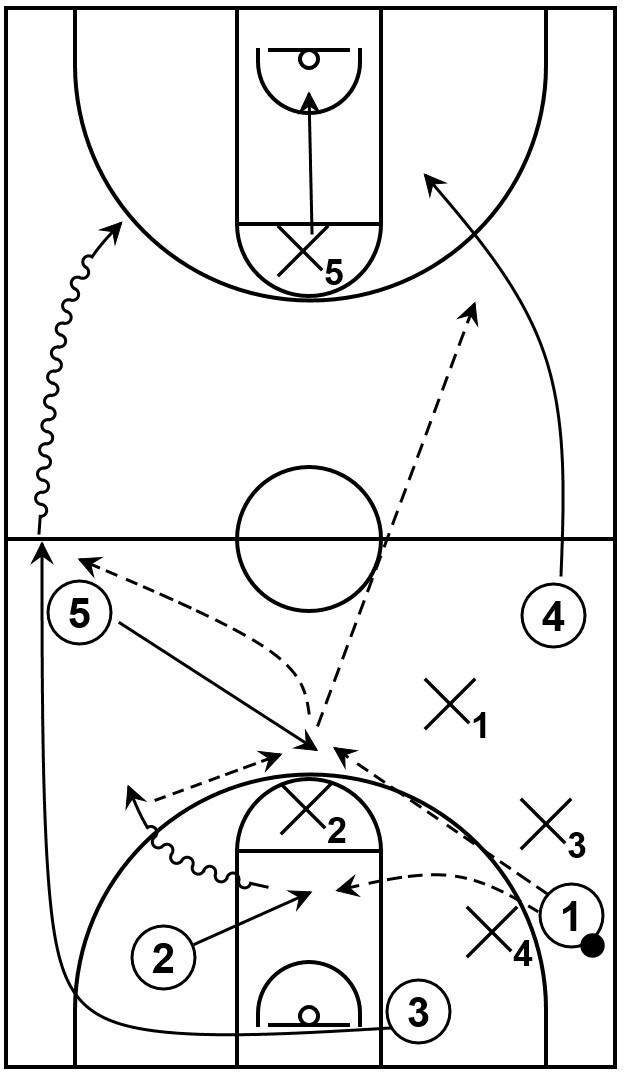Basic information about overhead pass
General definition
The overhead pass consists of action that occurs when a player in current possession of the basketball places it over their head before throwing it with two hands towards a teammate who is able to receive it.
Potential advantage
Generally speaking, since the overhead pass is thrown over the head, as the name suggests, it will typically have an above average amount of speed, velocity, and power, especially when compared to other types of passes such as the chest pass or bounce pass.
That extra speed, velocity, and power could help the ball reach its recipient at a faster pace, which could give the offensive team a potential advantage to one degree or another.
This is even more of a possible factor if the defensive team is not able to hinder the ball’s momentum or recover in enough time to efficiently guard against the recipient of the pass.
Example situations of overhead pass general usage
This section showcases example situations when the overhead pass could be utilized, especially during a basketball game.
Additionally, each of the offensive and/or defensive players on any diagrams below are generally represented by the standard basketball positions, unless otherwise noted.
In essence, 1 and X1 are the offensive and defensive point guards, respectively.
2 and X2 are the offensive and defensive shooting guards, respectively.
3 and X3 are the offensive and defensive small forwards, respectively.
4 and X4 are the offensive and defensive power forwards, respectively.
5 and X5 represent the offensive and defensive center positions, respectively.
Transition fast break
The overhead pass could be utilized during transition offense, mainly to get the ball down the court quickly, which could then lead to a fast break scoring opportunity.
The example diagram in the subsection below demonstrates this concept.
Overhead pass from backcourt to frontcourt

First, for this example, let’s assume that the opposing team (not shown) has just took a field goal attempt and missed the shot.
Second, let’s also assume that the missed shot was then collected as a defensive rebound by 5, who initially has possession of the ball, represented by the black dot.
As that happens, the offensive team is currently in their backcourt and ready to start their transition scoring opportunity.
So, 1 initially executes a v-cut to get open and receive the ball from 5.
However, as that happens, 2 leaks out towards the offensive team’s frontcourt looking to receive the ball as well.
From there, let’s say that 2 receives the ball from 5 via a long-distance overhead pass, which is also an outlet pass in this instance as well.
Moreover, as that occurs, the other offensive players begin to sprint down the court too.
Afterwards, 2 dribbles the ball (represented by the wavy arrow) toward the lane and scores via a layup at the basket.
Overhead pass counter against off-ball help defense
The overhead pass could be used to quickly move the ball from one side of the court to the other side, particularly as a counter to off-ball help defense action.
In other words, an offensive player can place the ball over their head and then throw it as a skip pass to a non-adjacent target, preferably before defensive players are able to guard the ball effectively in its new location.
The example diagram in the subsection below demonstrates this concept.
Overhead pass from wing to opposite corner

In terms of the initial setup: 1 is at the top; 2 operates at the right side wing area with possession of the ball; 3 occupies the left side wing area; 4 fills the left side corner; 5 occupies the right side low post area.
In relation to the defensive players; X1, X3, and X4 are in off-ball helping positions. X1 is near the nail in the middle of the high post. X3 is near the high post elbow on the left side. X4 is near the left side low post area.
Additionally, X2 is guarding 2 with on-ball defense while X5 guards 5 off the ball as well. Moreover, both of those defenders are currently on the strong side of the court.
What’s more, in this instance, the help defense action by X4 could be thought of as secondary basket protection in addition to pressure relief as a fallback for X5.
In essence, X4 slides over towards the left side low post area to help protect the basket in the possible event that 2 is able to blow by and beat X2 off the dribble while attacking the rim.
Moreover, if offensive players 1, 3, or 4 were to perform a basketball cut towards the rim, then X4 also has the potential capability to hinder or totally prevent those players from either receiving the ball or scoring it around the basket.
However, since X4 is further away from 4, this gives 2 an opportunity to throw an overhead pass, particularly by skipping it to 4, especially if the hands of X2 are down near their sides or simply too low in general.
This also means that X4 has to closeout back towards 4, represented by the solid black arrow, ultimately to prevent a potentially wide open three-point shot opportunity.
Furthermore, it is not shown on the diagram but even on a closeout, 4 could still possibly fake and drive towards the rim, which would then put more pressure on X5, who would have to try to guard both 4 and 5, a challenging task.
The main point of this particular example though is to show how the overhead pass, especially as the skipping variation, could be utilized to keep the defense on their toes and preferably uncomfortable to one degree or another.
Overhead pass counter against on-ball defensive pressure
The overhead pass could be utilized in certain situations against on-ball defensive pressure, particularly against traps or double team tactics.
Generally speaking, the offensive player can carry this out by jumping in the air and throwing an overhead pass to a teammate. Moreover, in this instance, this is also known as a jump pass because the player jumps in the air to throw the ball.
It should be mentioned though that the jump pass is at least somewhat risky because if the offensive player does not release the ball before making contact with the ground again, then that would most likely result in a traveling violation and subsequent turnover.
Furthermore, when a player jumps off the ground and becomes airborne, that typically gives the defense more time to read and react to the situation and potentially step into the passing lane to steal the ball, which also leads to a turnover.
Therefore, due to the aforementioned risks of the jump pass, it is generally more effective for an offensive player to throw this type of pass when a potential recipient is not too far away.
That is to say, the jump pass is generally less risky when a teammate who would receive the ball is either on the same side of the court as the passer or that possible receiver is cutting towards the ball.
Overhead pass vs. backcourt corner trap – Part 1

This is an example of a defensive team implementing a 1-2-1-1 press, which the offensive team attempts to counter by setting up a press breaker.
In terms of the offensive team’s setup within their backcourt: 1 and 2 form a small stack near the free throw line; 3 is the team’s inbound passer behind the baseline; 4 and 5 occupy the spots near the sidelines.
To start the action, 1 performs a V-cut towards the ball while 2 cuts in the opposite direction.
1 receives the ball from 3 who also steps onto the inbound side of the court.
Additionally, as that occurs, X2 slides over toward the free throw line, X1 slides over towards the extended slot area between the top and the wing, and X4 slides toward the ball to implement on-ball pressure.
From there, 1 should wait for either 4 or 5 to cut towards the middle of the court as potential recipients of a pass, ultimately to exploit the primary gap of the press defense.
However, let’s say that the on-ball pressure of X4 influences 1 to dribble towards the adjacent sideline, which is a detriment for the offense and benefit for the defense. As a result, X3 and X4 can set up a trap.
Overhead pass vs. backcourt corner trap – Part 2

At this point, 1 is trapped in what is sometimes referred to as a coffin corner. In essence, 1 cannot release pressure of the defensive trap, especially by way of an escape dribble or via other types of common dribble moves such as the crossover dribble.
It might be possible for 1 to split the trap by dribbling in between X3 and X4. However, the risk there is that one of the defenders could directly steal the ball when 1 attempts to dribble it between them or 1 could simply lose handle of the ball while attempting to split dribble.
Either situation could result in a turnover. Therefore, to mitigate some of the risk, it is probably better for 1 to pass the ball to an available teammate, assuming one is open to receive it.
For this case, 1 could do that by jumping in the air and throwing an overhead pass over the outstretched arms of the defenders, assuming that is possible as well. In other words, the defenders are not too tall and/or the defenders do not possess arm length that allows at least one of them to deflect the potential overhead pass.
Continuing on, let’s say that 2 cuts towards the middle of the lane while 5 cuts towards the top behind the three-point line, also in the middle of the court. At the same time, 3 begins cutting down the opposite sideline.
Furthermore, let’s say that 1 jumps in the air and throws the overhead pass to 5. When that happens, 3 could then receive the ball from 5 and begin dribbling down the court while 4 sprints toward the basket as well.
X5 would probably retreat to protect the basket. 3 and 4 can then try to score via 2 on 1 action.
Alternatively, if 4 possesses adequate dribbling skills, then 5 could throw the ball to 4, which could be an overhead pass as well. Following that, similar 2 on 1 action could happen between 3 and 4.
Conversely, let’s say that 5 is not open because X2 moved into the nearby passing lane. When that occurs, 1 could throw an overhead pass with 2 as the receiver. Next, 2 could dribble out beyond the three-point line and pass the ball to 5, which could lead to similar action as before.
It should also be noted if no teammates are open to receive the ball, 1 still may be able to burn a timeout. This is not necessarily ideal but it is usually better than getting the ball stolen or being charged with a time violation such as a 10-second count in the backcourt; both of which result in a turnover.
Additional concepts and insights about the overhead pass
General instructions for executing the basic overhead pass
Generally speaking, to execute the basic overhead pass while in possession of the ball on the floor, a player should initially be in a proper stance, put both hands on the ball slightly over their head, step towards the receiver of the pass, and finally release the ball by throwing it to that same receiver.
Get in proper stance
In terms of the proper stance for executing the overhead pass, a player should have both feet about shoulder width apart, knees bent slightly, eyes looking forward, and back straightened.
Place both hands on the ball
The player should place both hands on the sides of the ball with a firm grip that is not too tight. Basically, the player should grip the ball with the finger pads and have the fingers slightly bent while holding the ball.
Moreover, the player’s palms should not touch the ball while the player is holding it. In other words, there should be a small pocket of space between the palms of the player and the ball itself.
This is essential to understand because if the player grips the ball too tightly and/or the ball rests on the player’s palms, then the overall speed, velocity, and power of the overhead pass would most likely be affected in a negative or unintended manner.
Put another way, the overhead pass would more than likely be thrown inaccurately if the player grips the ball too tightly or not tightly enough.
Next, after gripping the ball properly, the player should hold it slightly over their head, but not directly behind their head, near the back of the neck area.
The player shouldn’t hold the ball directly behind their head because that would almost certainly have a negative impact on the speed, velocity, and/or power of the overhead pass as well.
Furthermore, the player’s elbows should be bent and pointing towards the targeted receiver while the ball is over their head.
The player’s elbows should not be pointing outward away from the receiver as that would also affect the speed, velocity, and/or power of the pass negatively.
Step towards the targeted receiver
After the player is in the proper stance while holding the ball over their head, that same player should then step towards the targeted receiver of the pass.
As far as which foot to step towards the receiver with, the player with the ball could technically always use the dominant foot, assuming there is not much on-ball pressure to hinder them.
Nevertheless, it is generally better to use whichever foot is adjacent to the direction of the pass.
For example, let’s say that there are three offensive players available, denoted simply as players 1, 2, and 3.
Let’s also say that 1 is at the top, 2 occupies the right side wing while 3 fills the opposite left side wing.
Additionally, 1 currently has possession of the ball and could pass it to either wing.
Let’s also say that 1 is right-handed and therefore, this same player’s dominant foot would typically be the right foot.
Following that, if 1 decides to throw an overhead pass towards 2, then 1 could simply step in that direction with the dominant foot, which also happens to be the right foot, in this specific case.
Conversely, if 1 decides to throw a overhead pass to 3, then 1 could step towards 3 with the dominant foot, which again, is the right foot in this case.
However, since 3 is on the left side of 1, it would usually be more effective and efficient if 1 were to step with the non-dominant foot, which is the left foot, in this instance.
The reason this is important to consider is because it is slightly quicker for 1 to step towards 3 (who is on the left side wing) with the left foot.
In other words, if 1 steps towards 3 with the dominant (i.e. right) foot, then that takes a little bit longer because 1 would have to turn their hips in the direction towards 3.
Release the ball
The player in possession of the ball should release it (i.e. throw it) towards the targeted receiver who should be ready to catch it, preferably near their chest area.
Also, when releasing the ball, the player should snap their wrists while generally pointing their fingers on both hands down towards the floor.
Furthermore, during the release, the player should extend their arms towards the receiver and straighten out their elbows from the initial bent position.
This basically verifies that the player in possession of the ball will throw it utilizing enough speed, velocity, and power so that the overhead pass could reach the receiver quickly and efficiently.
One of the basic passes
The overhead pass is one of the basic passes alongside the chest pass and the bounce pass that players should typically learn before executing additional more advanced types of passes.
A type of air pass
The overhead pass is also a type of air pass because it is thrown via the air from its source (i.e. the player in possession of the ball) to a destination (i.e. a receiver of the pass).
Consider at certain times
Generally speaking, a player in possession of the ball can consider using the overhead pass, particularly by skipping it, especially if the targeted receiver of the ball is a significant distance from the passer.
A simple example of this would be something like an offensive player with possession of the ball near a wing throws an overhead pass that gets skipped to a teammate on the opposite wing or opposite corner.
In that particular case, the recipient would be more than one pass away, which could be a great opportunity to throw the overhead pass by skipping it.
Putting it another way, when a targeted receiver is more than one pass away, this generally means that, outside of a skip pass, the ball would have to go through at least one other person before reaching the targeted receiver.
Using another example similar to the previous one, let’s say that the ball is near a wing and the targeted receiver occupies the opposite wing.
In that instance, outside of a skip pass, especially an overhead one, the ball would have to be received first by at least one offensive player at the top or within one of the slots before reaching the opposite wing.
This particular action, while technically feasible, works more to the benefit of the defense, especially if the general objective of the offensive team is to score points via high percentage open shots and/or take advantage of possible gaps while the defense is shifting from one area to another.
However, it should be noted though that the basic overhead pass itself does not always have to be thrown when the target is a long distance.
Instead, as mentioned, the overhead pass via skip action is probably best for that type of situation. As for the basic overhead pass, that can be thrown in a wide variety of different situations, even if the target is not too far away.
Simple practice drill
A player can practice and improve the overhead pass with a simple drill.
Basically, the player would stand about four to six feet away from a wall. Next, the player would execute the overhead pass by throwing the ball with both hands to an area of the wall that is slightly above the player’s head.
Afterwards, the player would then catch the ball with both hands as it bounces off the wall.
This basic wall passing drill could be completed over and over until the player is comfortable executing the overhead pass with high confidence.